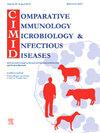对确诊患有猫泛白细胞减少症的埃及猫进行肉食原病毒 1 的分子分型。
IF 2
3区 农林科学
Q4 IMMUNOLOGY
Comparative Immunology Microbiology and Infectious Diseases
Pub Date : 2024-10-31
DOI:10.1016/j.cimid.2024.102273
引用次数: 0
摘要
猫的猫白细胞减少症(FPL)是由猫细小病毒(FPV)或犬细小病毒(CPV-2)引起的,这两种病毒属于同一物种 "肉食性原发性细小病毒 1"。虽然人们普遍认为 FPV 是导致 FPL 的主要原因,但在埃及最近的一项研究中,CPV-2 在病猫中的检出率却高于 FPV。为了评估这一矛盾,本研究旨在确定哪种原发性卡里沃兰病毒 1 通常与埃及猫的 FPL 有关。从 2022 年 12 月到 2024 年 1 月,对 43 只患有急性肠胃炎并在诊所内使用 SNAP® parvo 检测法检测出 FPL 阳性的猫进行了传统 PCR Protoparvovirus carnivoran 1 DNA 检测。通过部分 VP2 基因测序对 Protoparvovirus carnivoran 1 进行了分型。此外,还对该疾病的流行病学方面进行了调查,包括季节性模式、病死率、中位数存活时间,以及FPL结果与年龄、性别、疫苗接种情况和临床症状(呕吐和腹泻)等选定因素之间的关联。所有猫的肉食原病毒 1 DNA 检测结果均呈阳性,所有猫(n=39)的 PCR 扩增子均检测出 FPV。根据记录,病例呈以下季节性模式:秋季出现,冬季达到高峰,春季下降,夏季消失。病死率为 41.6%,中位死亡时间为两天。所研究的因素都不会影响 FPL 的结果。总之,埃及猫群中的FPL主要是由FPV而非CPV-2引起的,而且在冬季特别流行。本文章由计算机程序翻译,如有差异,请以英文原文为准。
Molecular typing of Protoparvovirus carnivoran 1 in Egyptian cats diagnosed with feline panleukopenia
Feline panleukopenia (FPL) in cats is caused by either feline parvovirus (FPV) or canine parvovirus (CPV-2), which belong to the same species “Protoparvovirus carnivoran 1”. While FPV is widely recognized as the principal cause of FPL, CPV-2 has been detected at a higher rate than FPV in sick cats in a recent Egyptian study. To assess this conflict, the present study aimed to determine which Protoparvovirus carnivoran 1 is commonly associated with FPL in Egyptian cats. From Dec-2022 to Jan-2024, 43 cats presenting with acute gastroenteritis and testing positive for FPL using in-clinic assay, SNAP® parvo, were tested for Protoparvovirus carnivoran 1 DNA using conventional PCR. Typing of Protoparvovirus carnivoran 1 was conducted by partial VP2 gene sequencing. Additional epidemiological aspects of the disease were investigated, including seasonal pattern, case-fatality rate, median survival time to death, and the association between FPL outcomes and selected factors like age, sex, vaccination status, and clinical signs (vomiting and diarrhea). All cats tested positive for Protoparvovirus carnivoran 1 DNA and FPV was detected in all cats with strong PCR amplicons (n=39). The following seasonal pattern was recorded: cases emerging in autumn, peaking during winter, declining in spring, and disappearing in summer. The case-fatality rate was 41.6 %, and the median time to death was two days. None of the studied factors affected FPL outcomes. In conclusion, FPL in Egyptian cat populations is primarily caused by FPV, not CPV-2, and is particularly prevalent in winter.
求助全文
通过发布文献求助,成功后即可免费获取论文全文。
去求助
来源期刊
CiteScore
4.60
自引率
0.00%
发文量
102
审稿时长
40 days
期刊介绍:
Comparative Immunology, Microbiology & Infectious Diseases aims to respond to the concept of "One Medicine" and to provide a venue for scientific exchange. Based on the concept of "Comparative Medicine" interdisciplinary cooperation between specialists in human and animal medicine is of mutual interest and benefit. Therefore, there is need to combine the respective interest of physicians, veterinarians and other health professionals for comparative studies relevant to either human or animal medicine .
The journal is open to subjects of common interest related to the immunology, immunopathology, microbiology, parasitology and epidemiology of human and animal infectious diseases, especially zoonotic infections, and animal models of human infectious diseases. The role of environmental factors in disease emergence is emphasized. CIMID is mainly focusing on applied veterinary and human medicine rather than on fundamental experimental research.

 求助内容:
求助内容: 应助结果提醒方式:
应助结果提醒方式:


